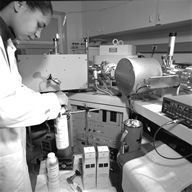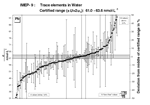
> Quality
of Chemical Measurements
> Europe's Favorite Chemists?
> News and Notices
> Symposia Reports
> New Projects
> Awards and Prizes
> New Books
> Commissions Reports
> Conference
Announcements
> Conference Calendar
Chemistry International
Vol. 23, No. 1
January 2001
Quality of Chemical Measurements (cont')
International Evaluation Program Reveals True Situation
Introduction
Background
The Problem
The BIPM Gets Involved
IRMM’s International Measurement Evaluation Program (IMEP)
A Practical Example: IMEP-9 Trace Elements in Water
The Way ForwardA Practical Example: IMEP-9 Trace Elements in Water
The IMEP rounds related to water analysis (3, 6, and 9) traditionally have had a large number of participants, thus reflecting people’s interest in water analysis. This interest is also expressed through several EU directives and national legislation that specifically addresses this topic.
Typically, each laboratory is requested to declare its level of competence as accredited/non-accredited and/ or self-declared experienced/less experienced to enable further interpretation of the data sets.
In all, three water IMEP rounds–and for most elements about 90% of the laboratories–reported values within 50% of the certified value. In a small numnber of cases, the reported values deviated from the certified value by more than 50%. Undoubtedly, these results should be judged by taking into account the required regulatory quality of the measurement (e.g., �10% in EC Directive 98/83/EC). The data (see Fig. 2) show that for most laboratories, this requirement poses a problem.
In IMEP-9, several "regional coordinators" acted on behalf of IRMM to liaise with participants, bridge linguistic and cultural differences, and take local particularities into account.
These coordinators were either people or institutions directly involved with chemical measurements, having a certain degree of experience and competence in metrology, and with links in the measurement systems of their country or region. Almost 85% of the participants were handled by the 13 regional coordinators, as shown in Table 3. Results were reported by 201 participants from 35 countries and 4 continents. A distribution of the participants as a function of the country is shown in Table 4.
IMEP in Support of a Global Metrological Structure for Chemical Measurements Samples used in IMEP-9 were offered to CCQM to be used in a key comparison (CCQM-K2), and nine National Measurement Institutes (NMIs) from all over the world measured these samples. Thus, the field laboratories (IMEP-9 participants) were able to compare their results with NMI results and vice versa. This exercise was one of the first-ever BIPM key comparisons in the area of chemical measurements, and it was successfully completed with IRMM as the pilot laboratory.
The importance of applying metrology to chemical measurements is clearly demonstrated by comparing the results obtained by the NMIs (Fig. 1) to the results obtained by the field laboratories (Fig. 2). The certified value for lead in the IMEP-9 CTS was 62.3 � 1.3 nmol/L. Eighteen of the 181 participating laboratories that measured Pb reported values more than 50% above the certified value, while 4 laboratories reported values 50% below. On the other hand, the NMIs participating in CCQM-K2–using a PMM test instrument–reported values within a fraction of a percent of each other and of the reference value.
Table 3 Regional coordinators of IMEP-9*
Institution/Organization* Origin Coordinating Region BELTEST, Brussels Belgium Belgium CCEN, Santiago Chile South America CAI, EA representative, Prague Czech Republic EA participants EMPA, St. Gallen Switzerland Switzerland HIM, Thessaloniki Greece Greece/Balkans IFA, Tulln Austria Austria/Donau basin LGC, Teddington United Kingdom United Kingdom NATA, Rhodes Australia Australia NIMC, Tsukuba Japan Japan NRC, Ottawa Canada Canada NMI, Delft Netherlands Netherlands NRCEAM, Beijing China China SP, Borås Sweden Sweden *Results were reported by 201 participants from 35 countries and 4 continents.Table 4 Participants' country of origin
Country Country Albania Italy 1 Argentina Japan Australia Korea Austria Norway Belgium Peru Bulgaria Republic of Moldova Canada Romania Chile Russia China Slovakia Cyprus Slovenia Czech Republic Spain Denmark Sweden Finland Switzerland France Netherlands Germany USA Greece United Kingdom Hungary Yugoslavia Ireland TOTAL
IMEP illustrates the need for a structured measurement system for chemical measurements. In such a system, various organizations and laboratories need to take on their responsibility, e.g., by agreeing on who assures demonstrated measurement capability for a particular measurement. IMEP is unique because it enables one to view the claimed measurement capability of different laboratories at various metrological levels, with an international perspective.
IMEP will continue to foster this perspective and grow, with particular focus on laboratories in the Member States of the EU as well as in the EU preaccession countries. In order to prepare the latter for integration into the EU’s measurement and accrediation systems, IRMM is offering:
- postdoctorate fellowships (2–3 years)
- detached national experts
- visiting scientists
In this way, IRMM will give training/advice on traceability and on uncertainty evaluation of chemical measurement results. Participants can take this expertise back to their home countries and/or become regional coordinators for IMEP in their respective countries. In collaboration with EUROMET and CCQM, IMEP samples are offered for the organization of EUROMET key or supplementary comparisons and, where appropriate, for the organization of CCQM key comparisons or pilot studies. In its role as a neutral, impartial international evaluation program, IMEP displays existing problems in chemical measurement. IRMM is dedicated to tackling this problem and will, where possible, collaborate with international bodies, education and accreditation authorities, and NMIs to achieve more reliable measurements and contribute to setting up an internationally structured measurement system.
Additional References �Demonstration� vs. �designation� of measurement competence: the need to link accreditation to metrology
P.De Bi�vre, P. Taylor Fresenius J. Anal. Chem. (2000) 368:567-573
> onlineAn Expanding International Measurement Evaluation Programme - IMEP P. Taylor, P.De Bi�vre, L.Van Nevel and U. Ornemark Eurachem Newsletter OR Eurolab Newsletter, December 1997 Metrology in Chemistry International program reveals wide variation in chemical measurements M. Freemantle Science/Technology May 31, 1999 Vol.77, Nr. 22, pp.29-32 The International Measurement Evaluation Programme (IMEP): Prospect for 1998 P Taylor, L.Van Nevel, U. Ornemark, I. Papadakis and P. De Bi�vre CITAC Newsletter, February 1998
> online
International Measurement Evaluation Programmes, IMEP Institute for Reference Materials and Measurements, IRMM Related IUPAC Projects Commission on Isotope Specific Measurements as References
to quality issueseqalm bipm ccqm citac eurachem
News
and Notices - Organizations and People
- Standing Committees
Divisions
- Projects - Reports
- Publications - Symposia
- AMP - Links
Page last modified 26 April 2001.
Copyright © 1997-2001 International Union of Pure and Applied Chemistry.
Questions or comments about IUPAC, please
contact the Secretariat.
Questions regarding the website, please contact [email protected]




